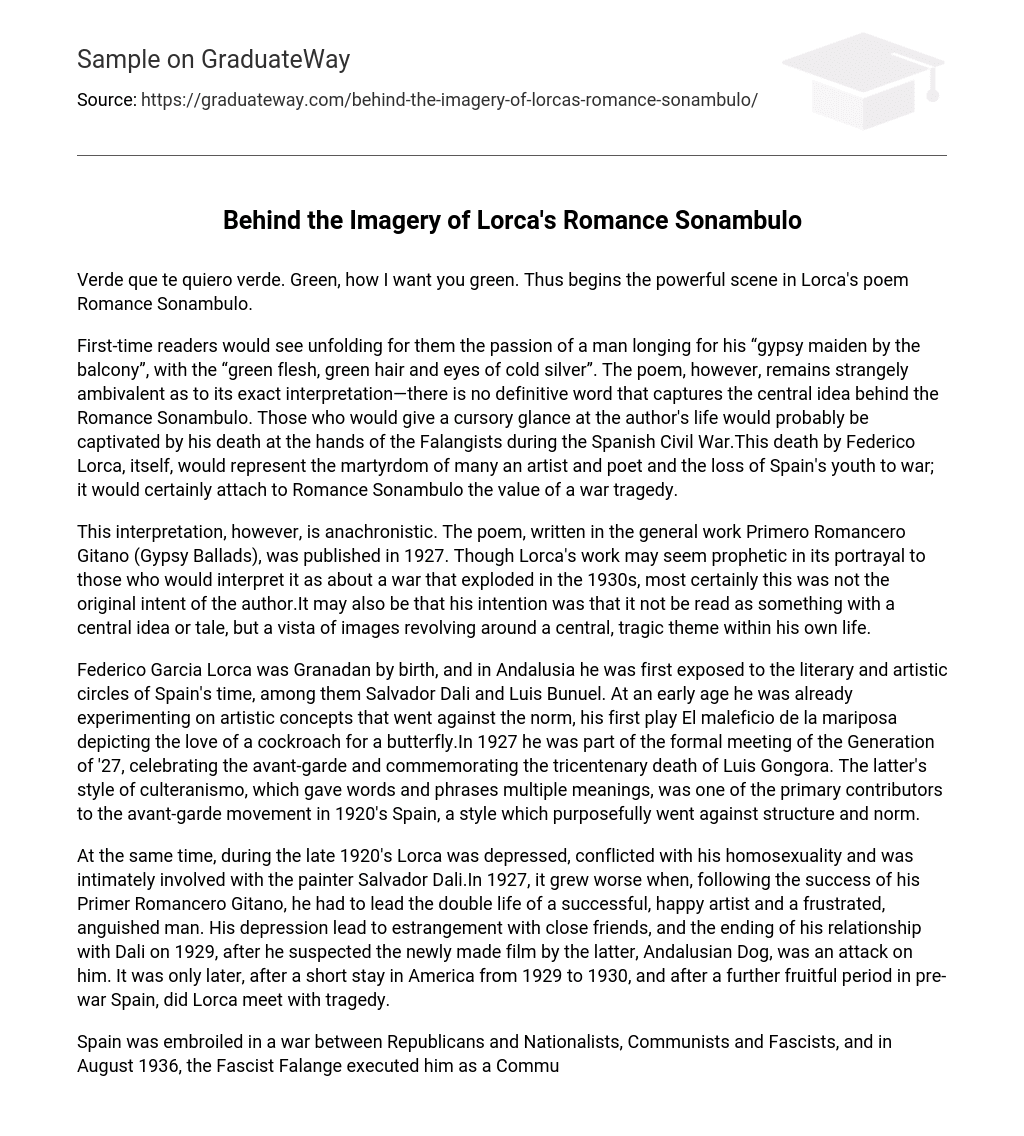Verde que te quiero verde. Green, how I want you green. Thus begins the powerful scene in Lorca’s poem Romance Sonambulo.
First-time readers would see unfolding for them the passion of a man longing for his “gypsy maiden by the balcony”, with the “green flesh, green hair and eyes of cold silver”. The poem, however, remains strangely ambivalent as to its exact interpretation—there is no definitive word that captures the central idea behind the Romance Sonambulo. Those who would give a cursory glance at the author’s life would probably be captivated by his death at the hands of the Falangists during the Spanish Civil War.This death by Federico Lorca, itself, would represent the martyrdom of many an artist and poet and the loss of Spain’s youth to war; it would certainly attach to Romance Sonambulo the value of a war tragedy.
This interpretation, however, is anachronistic. The poem, written in the general work Primero Romancero Gitano (Gypsy Ballads), was published in 1927. Though Lorca’s work may seem prophetic in its portrayal to those who would interpret it as about a war that exploded in the 1930s, most certainly this was not the original intent of the author.It may also be that his intention was that it not be read as something with a central idea or tale, but a vista of images revolving around a central, tragic theme within his own life.
Federico Garcia Lorca was Granadan by birth, and in Andalusia he was first exposed to the literary and artistic circles of Spain’s time, among them Salvador Dali and Luis Bunuel. At an early age he was already experimenting on artistic concepts that went against the norm, his first play El maleficio de la mariposa depicting the love of a cockroach for a butterfly.In 1927 he was part of the formal meeting of the Generation of ’27, celebrating the avant-garde and commemorating the tricentenary death of Luis Gongora. The latter’s style of culteranismo, which gave words and phrases multiple meanings, was one of the primary contributors to the avant-garde movement in 1920’s Spain, a style which purposefully went against structure and norm.
At the same time, during the late 1920’s Lorca was depressed, conflicted with his homosexuality and was intimately involved with the painter Salvador Dali.In 1927, it grew worse when, following the success of his Primer Romancero Gitano, he had to lead the double life of a successful, happy artist and a frustrated, anguished man. His depression lead to estrangement with close friends, and the ending of his relationship with Dali on 1929, after he suspected the newly made film by the latter, Andalusian Dog, was an attack on him. It was only later, after a short stay in America from 1929 to 1930, and after a further fruitful period in pre-war Spain, did Lorca meet with tragedy.
Spain was embroiled in a war between Republicans and Nationalists, Communists and Fascists, and in August 1936, the Fascist Falange executed him as a Communist. It would be tempting to allude Romance Sonambulo to the tumultuous decade, since along with Lorca, the other members of the Generation of ’27 were imprisoned, killed or exiled. However, the darkness within the Romance Sonambulo is best paralleled with Lorca’s period of anguish, his affairs and that latter period of the 1920s.The literary artist tended to fuse popular and folk traditions within his work, hence the imagery of the “gypsy against the moon”, the “horse on the mountain” and the “ship on the sea”.
From the title, sonambulo meaning sleepwalking, one could understand that the poem was not meant to be taken in the literal sense. The character portrayed as longing for the “verde viento, verde ramas” was possibly caught in a dreamlike state, urged on by his ardent desire to see his gypsy maiden.In the avant-garde tradition, Lorca had the imagery of the “horse on the mountain” and the “ship on the sea” parallel to the action of the dying man struggling to see his gypsy maiden. If we are to interpret the Romance Sonambulo as a dreamlike tragedy, then it is possible that Lorca may have alluded the poem to his homosexuality, and that the gypsy maiden with the “green hair” and the “green flesh” and the man running to see her may be the same person.
The man would represent Lorca, the wound from “throat to chest” symbolizing his mortal anguish and depression over his sexuality, and his desire to see the “ verde viento, verde ramas” may be his desire to become that gypsy maiden. The maiden’s longing for something may very well represent Lorca’s feeling of a “womanhood” waiting to burst from within him. This is further alluded by his trading of his “horse for her house”, and “saddle for her mirror” as representing him giving up the symbols of himself and his manhood for the identity of the gypsy, to be the gypsy.His continually leading a double life, and his personal conflict over his sexuality, is indicated by the reply that “I am not I” and “my house is not my house”; he no longer understand who he was, or why he was.
The final scene of the man finding the fate of the gypsy maiden “swinging by the mouth of the cistern”, with the “Guardia Civiles” pounding at the door, could represent Lorca’s fear of social persecution, or even of his condemnation by the State, should he finally admit to his homosexual feelings.He is “killing” his “womanhood”, out of fear of ostracism. Green is generally associated with nature, a sense of freedom from anxiety and anguish. At the same time, it has been attributed to sexuality.
In that sense, Lorca’s poem may attribute green to a desire to return to the natural state, and a freedom of expression of one’s sexuality. Verde que te quiero verde may be Lorca crying out to be free, and to find a resolution to who he is.





